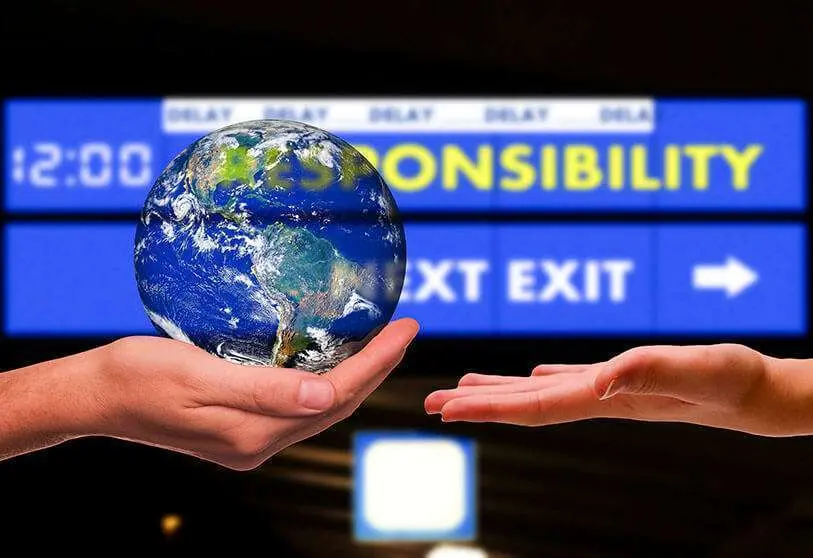Split the planet into two parts

Since August 22nd the Earth has been living on credit. That day marks the time of year when the 7.7 billion people who populate the planet have exhausted all the resources produced in a year. Therefore, until 31 December everything that is spent or consumed in real terms means accelerating a little more the disappearance of reserves and their diminishing renewal. It is the day known as Overshoot Day, which since 1970 has marked the moment when each year human beings have literally eaten up the food, energy and ecological resources that the Earth is capable of producing or renewing. It is measured by the Global Footprint Network (GFN), the international research institute in California, which uses a list of 15,000 data established by the United Nations.
Since 1970, the annual date on which humanity exhausts resources has only advanced, with the sole exception of this year, 2020, when the general confinement due to the coronavirus pandemic has given Mother Nature a break. In fact, both 2018 and 2019 the overshoot day was 29 July. This would demonstrate that only the adoption of drastic universal measures can stop and even reverse the trend of destroying our planet's capacities. It is true that the containment was not a voluntary measure, taken for the benefit of the Earth, but imposed as the most effective means of mitigating the uncontrollable advance of the COVID-19 virus. As GFN President Mathis Wackernagel states, "if it is not accompanied now by a systemic change in our modes of production and consumption, it will be of no use".
Since the introduction of this calendar in 1970, the balance of each day's overcapacity has marked various periods of acceleration, the most dramatic coinciding with those in which the habit of throwing away has been imposed. Thus, between 1971 and 1995, the deterioration of the planet progressed until 4 October 1995 was marked as the date of annual exhaustion. Since then, massive production and consumption, with its corresponding generation of real mountain ranges of unrecycled waste, has triggered pollution, global warming, the disappearance of permafrost and numerous glaciers. Humanity exhausted its resources on September 23rd in the year 2000, on August 25th in 2005 and on August 5th in 2015, to then shoot up until the aforementioned July 29th in 2019. This year's retreat therefore indicates that it is not impossible to make major and rapid changes to reverse the impact on the ecological footprint. Because, if we continue on the current path, the GFN warns that it would take the equivalent of six planets Earth to meet our needs to drink, eat, heat or travel.
Not all humans contribute equally to the planet's broken seams. A simulation, compiled by the newspaper Le Monde, establishes a classification of the biggest consumers of resources. The table places Qatar at the top, so that if all 7.7 billion human beings could and wanted to adopt their way of life it would take the equivalent of 8.9 planets Earths each year, followed by Luxembourg, which would need 7.9 Earths. The American way of life transferred to the whole world would need 5 while if we all lived according to the ways, customs and traditions of India it would only need 0.3, that is, the Earth would have a surplus of two thirds.
The GFN is pessimistic that the positive lessons drawn from confinement - a sharp drop in carbon dioxide in the atmosphere, cleaner rivers and seas, recovery by wildlife of part of their lost territories - do not translate into global measures. China, for example, has returned to pre-pandemic levels of industrial pollution emissions since it began to ease its drastic containment measures in March. A trend that is feared to occur in the rest of Asia. In the Americas and Africa, the huge fires in the Amazon and the strip between the equator and the tropics are increasing the devastation, desertification and erosion of the planet, whose marine and fresh waters are becoming increasingly polluted by plastics and metals, with striking examples in the Atlantic and Pacific oceans, or on a smaller scale in the Mar Menor, once a crystalline jewel of the Spanish Levantine coast, now a dead lagoon.
The Global Footprint Network offers governments a more optimistic outlook. If there were agreement to reduce greenhouse gases by 50%, the overshoot day would be set back by no less than 93 days. And if the same 50% reduction in food waste were achieved, another 13 days would be gained. And the final figure, if humanity were able to gain 5 days each year until 2050, we would once again have a planet that is sufficient to renew itself and provide us with everything we need for life, without stressing or breaking down.

